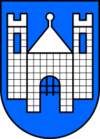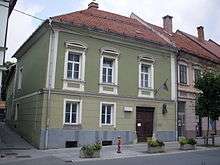Slovenj Gradec
Slovenj Gradec (pronounced [slɔˈʋeːŋ ˈɡɾaːdəts] (![]()
Slovenj Gradec | |
|---|---|
 Coat of arms | |
 Slovenj Gradec Location in Slovenia | |
| Coordinates: 46°30′33.69″N 15°4′44.97″E | |
| Country | |
| Traditional region | Styria |
| Statistical region | Carinthia |
| Municipality | Slovenj Gradec |
| Area | |
| • Total | 5.60 km2 (2.16 sq mi) |
| Elevation | 413 m (1,355 ft) |
| Population (2020)[1] | |
| • Total | 7,249 |
| • Density | 1,300/km2 (3,400/sq mi) |
| Postal code | 2380 |
| Climate | Cfb |
| Licence plate | SG |
| Website | www |
History
Gradec, Slovene for 'little castle', was first mentioned in a 1091 deed, then part of the Imperial March of Styria. The prefix Windisch (the traditional German name for Slavs in general and Slovenes in particular) was added to distinguish it from the city Graz (whose name has the same etymology). The modern Slovene name, Slovenj Gradec (literally: the Slovene Graz), derives from this German denomination. From 1180 until 1918, Slovenj Gradec belonged to the Duchy of Styria, since 1804 a crown land of the Austrian Empire. It was the ancestral seat of the Windisch-Graetz noble family first documented in 1220.[2] Upon the dissolution of Austria-Hungary in 1918, with the rest of Lower Styria, it was included in the newly established Kingdom of the Serbs, Croats and Slovenes.

Until 1918, the town was a German-speaking island in a Slovene-speaking area. In the 1880 census, the town of Slovenj Gradec was 75 percent German-speaking and 25 percent Slovene-speaking.[3] Many inhabitants, like the family of the composer Hugo Wolf, were of mixed ethnic origin. After the end of World War I, many of the local German-speaking inhabitants emigrated to Austria. Those who remained were gradually assimilated into the now Slovene-speaking majority. During World War Two, the town was occupied by the Nazis and annexed to the Third Reich. The local Slovenes were submitted to a policy of violent Germanization and many died of various persecutions. The partisan insurgency developed in the area, especially in the hills to the east of the town. After World War II, the remaining ethnic Germans were expelled from Yugoslavia, and Slovenj Gradec lost its traditional presence of German speakers.
From the 1950s onward, the town experienced a rapid industrialization and eventually became the unofficial economic and political center for Slovenian Carinthia. In 1994, it became one of the 11 towns in Slovenia with the status of City (or Urban) Municipality.
Main sights
The parish church in the town is dedicated to Saint Elizabeth of Hungary and belongs to the Roman Catholic Archdiocese of Maribor. It was first mentioned in written documents from 1235. Next to it stands a Gothic chapel dedicated to the Holy Spirit with frescos dating to the mid-15th century.[4]
In 1994, an archaeological excavation uncovered the remains of what is believed to be the oldest church in Styria, dating to the Carolingian period (second half of the 9th century).[5]
The Slovenj Gradec Art Gallery (Slovene: Koroška galerija likovne umetnosti) was founded in 1957 and is located on the first floor of the old town hall in the town centre. The gallery hosted international fine art exhibitions under the sponsorship of the United Nations in 1966, 1975, 1979, 1985, and 1991. The 1997 exhibition "The Artist and Urban Environment" displayed art activity in Peace Messenger Cities from all over the world. In 2012, Slovenj Gradec and Ptuj were partners with Maribor, the European Capital of Culture. As a result, the gallery presented further exhibitions that attracted Europe-wide attention.[6]
Notable residents
Notable people that were born or lived in Slovenj Gradec include:
- Roman Bezjak (born 1989), footballer
- Katarina Čas (born 1976), actress
- Sašo Fornezzi (born 1982), footballer
- Ivan Gams (sl) (1923–2014), geographer
- David Kiselak (born 1988), footballer
- Lado Kralj (born 1938), writer, theatre critic, and literary historian
- Tina Maze (born 1983), skier, Olympic champion
- Boštjan Nachbar (born 1980), basketball player
- Vinko Ošlak (born 1947), author
- Karel Pečko (1920–2016), artist
- Iztok Puc (1966–2011), handball player
- Renata Salecl (born 1962), philosopher
- Adi Smolar (born 1959), singer-songwriter
- Katarina Srebotnik (born 1981), tennis player
- Ilka Štuhec, alpine ski racer
- Marko Šuler (born 1983), football player
- Nikola Tolimir (born 1989), footballer
- Tadej Trdina (born 1988), footballer
- Hugo Wolf (1860–1903), composer. The house in which he was born is now a music school and museum.
International relations
Twin towns — Sister cities
Slovenj Gradec is twinned with:
Charter of cultural cooperation was signed with Bardejov, Slovakia.
International Association of Peace Messenger Cities
Since 1989, Slovenj Gradec was one of the most active and progressive cities within The International Association of Peace Messenger Cities, being a member of its executive board since 1997 and secretary-general of this organization in periods 2007–2010, 2010–2013, 2013–2016, and 2016–2019.
References
- "Naselje Slovenj Gradec". Statistični urad Republike Slovenije. Retrieved October 14, 2019.
- Der Große Brockhaus, Leipzig 1935, vol. 20, p. 359
- Meyers Konversationslexikon, 5th ed., Leipzig-Vienna 1897, vol. 17, p. 794
- Slovenian Ministry of Culture register of national heritage reference numbers ešd 658 & 659
- Mira Strmčnik, Sveti Jurij, zakladnica podatkov, Izvršni svet Skupščine občine Slovenj Gradec, 1994
- Koroška galerija likovne umetnosti
External links
| Wikimedia Commons has media related to Slovenj Gradec. |
